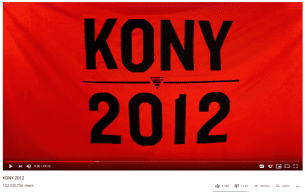
On March 5, 2012, Jason Russell, co-founder of the NGO Invisible Children, uploaded a 30-minute film on YouTube titled Kony 2012. In this short film, Russell introduced Americans to the plight of children in northern Uganda who live in fear of being kidnapped by warlord Joseph Kony. With over 100 million views in just six days, this video quickly became a viral sensation, blanketing the feeds of many social media users (Kanczula, 2012). After visiting Africa in 2003 and witnessing the violence led by Kony, Russell says that he was compelled to raise awareness about this vicious Ugandan group in hope that the United States government would intervene to stop this humanitarian tragedy. His short film focuses on Jacob, a Ugandan boy who lost his brother to the Lord’s Resistance Army (LRA), a group of armed rebels serving Kony that was founded in 1987. The LRA terrorizes African children, forcing them to mutilate the faces of innocent people and kill their parents. Jacob describes the horror of life in Uganda and how he lives every day in fear of the rebels. Jacob is not alone: more than 30,000 Ugandan children have become victims of Kony and the LRA’s inhumane tactics. Russell’s work is both provocative and hopeful: when Jacob cries in the film in fear of one day being kidnapped, American voices console him and make the promise: Kony will be stopped.
This video was very successful in capturing the attention of concerned social media users: over 4 million tweets mentioned Kony after its release (Kanczula, 2012). Brendon Cox, director of policy and advocacy for Save the Children, an NGO with a similar mission to Invisible Children, states that he supports the Kony campaign because “Anything which continues to pressurize world leaders to bring Joseph Kony to justice is to be welcomed…This viral film shows that even though Joseph Kony is in hiding his crimes will not be forgotten.” In addition to creating the most viral video in history, the campaign led to President Obama’s deployment of a small number of U.S. troops in 2011 in an ultimately unsuccessful attempt to capture Kony. Support for Invisible Children’s campaign involved over three million social media users who pledged to support “Stop Kony 2012,” including notable celebrities like Oprah and Bill Gates. Many of these supporters gave money to the campaign: over $28 million was raised to publicize the fight against Kony in 2012 alone (Curtis et al., 2012).

Reactions to this instance of online activism were mixed, since it was premised on making Kony’s activities highly public. The goal of this campaign, reiterated many times in Russell’s film, was to make Kony “famous.” While Oprah donated $2 million to this information-based activist campaign, Ugandans threw rocks during a public screening of the film (Smith, 2012). A young Ugandan man captures the source of this anger after the screening by asking, “How can anybody expect me to wear a T-shirt with Kony’s name on it?” Beyond the publicity, others worry about this strategy of making a trend out of unjust individuals. What happens when the trend dies out? “Kony is so last month,” claimed a Twitter user soon after the initial enthusiasm of the campaign faded (Carroll, 2012). Many Ugandans took offense to this American organization’s campaign and its supposed colonial nature. Ugandan journalist and blogger Rosebell Kagumire claimed that the film “makes out a narrative that is often heard about Africa…about how hopeless African people are in times of conflict” (Curtis et al., 2012). Others voiced concern with potential ulterior motives and short cuts involved in the activist campaign. The film’s sensationalization of Kony and the LRA strategically presented certain information, including hiding the fact that Joseph Kony hadn’t been in Uganda for six years before 2012. Filmmaker Simon Rawles voiced concerns about the motivation for such a persuasive retelling: “I felt a little nauseous watching the film. Couldn’t help but feel the director’s concern was less about addressing the needs of those affected today by the LRA and the complexities of tackling the rebel group, than as serving as a very slick promotional vehicle for his charity” (Curtis et al., 2012). There are some grounds to support this criticism, such as the fact that Invisible Children only spent about 30% of their revenues for directly helping Ugandans affected by the LRA, while the rest was used for film production and staff salaries (Goldberg, 2017).
Others worry that Kony 2012 is a case of “slacktivism,” or easy online efforts being mistaken for real and effective activist movements. Offline efforts connected with this campaign went nowhere: while Russell ardently pleaded for supporters across the world to “cover the night” on April 20, 2012 (i.e., vandalize their hometowns so that Kony’s name would be everywhere), turnout was abysmal. In Los Angeles, the streets were mostly free of Kony posters and young activists (Carroll, 2012). Likewise, in Sydney, Australia, out of 19,000 who registered online to attend a Kony 2012 rally, only 25 actually participated (Marcus, 2012).
Despite the apparent enthusiasm of internet activists, Joseph Kony is still alive and in power in Uganda. The Kony 2012 campaign seemed to raise many questions concerning the ethics and effectiveness of online activism: can social good come out of making the horrific crimes against Ugandan children a “trend” and their tormenter “famous?” Is such publicity-based activism on social media usefully raising awareness, or is it simply a too-easy “slacktivism?”
Discussion Questions:
- Was Kony 2012 an ethically-worthy film? Was the campaign surrounding it ethically valuable? What ethical issues does this film raise?
- Does the effectiveness of the film and campaign matter for your moral appraisal of Russell’s efforts? Why or why not?
- Is the Kony 2012 campaign an instance of innovative activism or mere “slacktivism?”
- What are the ethical concerns with enhancing the publicity or visibility of those doing immoral actions? How might such plans backfire, and what can be done to make them ethical and effective?
Further Information:
Carroll, Rory. “Kony 2012 Cover the Night fails to move from the internet to the streets.” April 21, 2012. Retrieved from https://www.theguardian.com/world/2012/apr/21/kony-2012-campaign-uganda-warlord
Goldberg, Eleanor. “Group Behind ‘Kony 2012’ Closing Because Of Funding Issues.” December 6, 2017. Retrieved from https://www.huffingtonpost.com/2014/12/16/invisible-children-closing_n_6329990.html
Kanczula, Antonia. “Kony 2012 in numbers.” April 20, 2012. Retrieved from https://www.theguardian.com/news/datablog/2012/apr/20/kony-2012-facts-numbers
Marcus, Caroline. “Kony 2012 campaign a giant flop in Sydney.” April 21, 2012. Retrieved November 15, 2018, from https://www.dailytelegraph.com.au/kony-2012-campaign-a-giant-flop-in-sydney/news-story/23ce5cec882dba81aa8c2058f5b29dcc
Smith, David. “Kony 2012 video screening met with anger in northern Uganda.” March 14, 2012. Retrieved from https://www.theguardian.com/world/2012/mar/14/kony-2012-screening-anger-northern-uganda
Curtis, Polly & McCarthy, Tom. “Kony 2012: What’s the real story?” March 8, 2012. Retrieved from https://www.theguardian.com/politics/reality-check-with-polly-curtis/2012/mar/08/kony-2012-what-s-the-story
Authors:
Michaela Urban & Scott R. Stroud, Ph.D.
Media Ethics Initiative
Center for Media Engagement
University of Texas at Austin
February 23, 2019
Images: Screencaptures from YouTube
This case study can be used in unmodified PDF form for classroom or educational settings. For use in publications such as textbooks, readers, and other works, please contact the Center for Media Engagement.
Ethics Case Study © 2019 by Center for Media Engagement is licensed under CC BY-NC-SA 4.0



